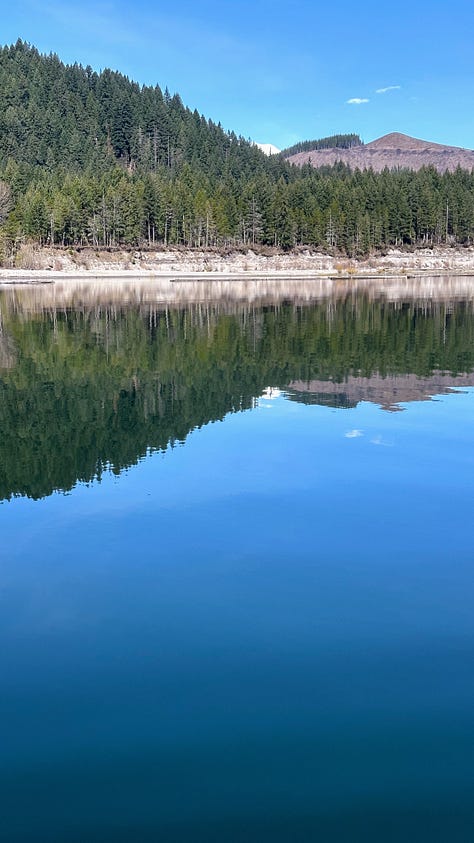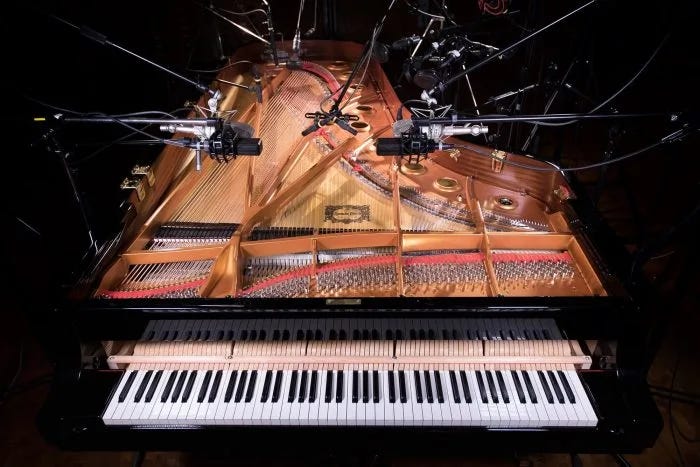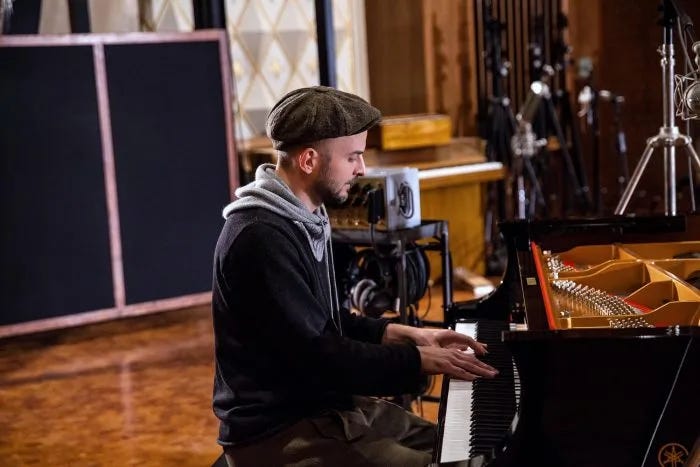MMNLS2E8.The ear is an instrument
Supplemental, field recordings, mics, ambience and "ambient"
This weekend I was lucky enough to spend a few days up at a cabin in the woods of Washington State. Decompressing, defragging, and filling up the tanks. Mediating, floating on a totally mirror-like lake in the kayak, cooking, listening to records, hiking in old forests that have never been cultivated or lived on by modern man. Pagan as fuck. I finished KLF, Chaos Magik, Free Food, and Orpho. (would recommend all of them, but this newsletter is music thoughts, not book recommendations)



It was incredibly quiet, there are no towns for 40 minutes in any direction, there is one road that skirts the camp, and occasionally you hear a logging truck rumble past, forest birds, an occasional dog bark, and the infrequent pickup.
All the silence got me thinking about the role of recording in music; mics are arguably the most unloved instrument in a recording studio, or on a record. I was listening to Jeff Parker recorded at ETA and was just blown away by the recording. It was captured in a space that has never even used amplification.
Jeff Parker’s ETA ensemble evolved from a band that played mostly standards into a group known for its transcendent, long-form (sometimes stretching out for 45 minutes or more) journeys into innovative, often uncharted territories of groove-oriented, painterly, polyrhythmic, minimalist and mantric improvised music. With that musical growth, the crowds for Parker and his band at ETA grew across the years too.
Bryce Gonzales (engineer) is well known for the high-end audio gear he builds as Highland Dynamics, and even designed a custom mixer to be able to record the ETA IVtet, specifically, while only taking up a single space at the bar. In his liner notes “There are many different ways to make recordings and they all have their place. But for this band, the most important thing to consider is: not doing anything to get in the way of what they are saying to each other.” He refers to the simple schematic he used for capturing these performances – “basically only 4 level controls for one microphone per player” – which allows us an incredibly pure, honest, transparent and transporting experience of the music as it unfolds and is created in real time.
I was thinking how mic use adds texture, an organic sound, with so much of my ears full of electronica, maybe this is why I am falling in love with live instrumentation so much. I remember
telling me about Nils Frahm’s set-up in Berlin, the contact mics on the piano so you could hear the creaks of the hammers, the squeak of his stool, the neighbours, the cat plodding across the room. This world building alwasy sucked me into a piece, gave it life beyond computers, programming, and grids.“Originally I wanted to do my neighbours a favour by damping the sound of my piano. If I want to play piano during the quiet of the night, the only respectful way is by layering thick felt in front of the strings and using very gentle fingers. It was then that I discovered that my piano sounds beautiful with the damper.’
Captivated by this sonic exposition, he placed the microphones so deep inside the piano that they were almost touching the strings. This brought a host of external sounds to the recordings which most producers would try their hardest to hide:
‘I hear myself breathing and panting, the scraping sound of the piano's action and the creaking of my wooden floorboards – all equally as loud as the music. The music becomes a contingency, a chance, an accident within all this rustling. My heart opens and I wonder what exactly it is that makes me feel so happy.’
In my head, while I was listening to the sound of the oar on the lake, I started to think about the fact that the microphone are not neutral players.
Despite what technology might tell us, the microphone isn’t a passive listener and recording device. It’s not there to only “capture” sound. In my world of ambient, experimental jazz, and electronics. it is an instrument in its own right. A player. A filter. A magician, a spell, a translator of energy and time.
Traditionally, recording techniques have been about clarity, fidelity, and “getting out of the way,” but maybe that takes something away; it sterilizes sounds. Like so much design these days, the post-modernism, the Bauhaus, the Dieter Rams, poor designers have mistaken this for purism. Ambient recording is about getting in the mix, making themselves known, warping sound, exaggerating the air, highlighting breath, bending what we hear into something new
Was thinking through some examples when I got home.
Two Microphones, Infinite Space: Free Jazz
Collective Calls (Urban) (Two Microphones) by Paul Lytton & Evan Parker. British free improvisation jazz from 1972, who worked with engineer Bob Woolford to limit themselves to just two microphones. But instead of defaulting to a stereo spread, they played with distance, reflection, and ambient bleed. The result isn’t just a record of two musicians; it’s a record of the room. You hear air vibrating, metal resonating, space itself becoming part of the performance.
Milford Graves, in his duo with Don Pullen (Nommo, 1967), miked his percussion through the floor picking up low-end vibrations and bodily thumps as if the drum kit was alive and breathing. More of a séance than a session.
Akira Sakata, in the early ‘80s included the use of throat and body mics to emphasize what he was doing breathing, straining, swallowing sound and spitting it out again. It’s messy. hard to listen at times, without the microphone right up in his lungs, it wouldn’t work.
So many great Jazz albums attempt to capture the energy, the organic playfulness of the moment, from John Coltrane’s work, Alice’s recordings at the Ashram, Miles Davis and Kind of Blue, Bill Evans (Sunday at the Village Vanguard) to name just a few - I could do a whole essay on live jazz recordings. And “Ambient” bangers - Brian Eno with Music for Airports, Stars of the Lid and even Tangerine Dream.
Ambient Music's Hidden Machinery
If jazz uses microphones to capture human energy, ambient music focuses on space, place, and process.
Jana Winderen records with hydrophones, capturing glacial ice shifting underwater, or fish vocalizations at frequencies we can’t hear. In her work (Energy Field, 2010), the ocean becomes a machine, the earth itself an instrument.
Francisco López takes a different tack. His 1998 album La Selva is a pure field recording of the Costa Rican rainforest, made with field mics. No instruments. Just 74 minutes of raw, environmental listening.
Tarab (Eamon Sprod) drags contact mics across crumbling concrete, feeds electromagnetic signals into cassette players, and lets the resulting noise create collages. It’s decayed, physical, made by the building itself.
Tetsu Inoue and his album World Receiver (1996), binaural mics hidden in eyeglasses recorded the minutiae of urban space, shuffling feet, overheard conversations, distant cars. On headphones, it’s startling. Not just spatial, but teleporting. You feel like you’re occupying someone else’s body, trapped in the city. Noah Jurcin aka Phonaut wrote this in the liner notes:
”The first time I heard World Receiver, it went over my head. After all, it was only the previous year that I had been introduced to Tetsu Inoue's music. By that time, Inoue had already completed a trilogy of solo efforts as well as host of full length albums in collaboration with other artists. These were mostly deep analog ambient sessions documented across more than two dozen cryptically decorated releases on Pete Namlook's Faxlabel in Germany. During the immersive 2350 Broadway and Shades of Orion sessions, Inoue developed a personal musical language which helped him create a rich, emotional listening experience while at the same time showcasing the outer sonic limits of synthesizers and samplers. At that time ambient music was experiencing a prolific renaissance period, an explosion of material resulting in a bewildering spectrum of all different sounds and fractured styles. Meanwhile, Inoue was also working with a number of other labels from all over the world and collaborating with other musicians including : Taylor Deupree, Andrew Deutsch, Haroumi Hosono, Bill Laswell, Ikue Mori, Uwe Schmidt, Jonah Sharp, Carl Stone and Stephen Vitiello. In the context of the rest of Inoue's discography, World Receiver emerged at an interesting time. It was on the cusp of marking the relative end of his earlier analog (and more ambient) works and the later digital recordings. World Receiver was essentially the first recording to effectively bridge these two types together. It is a triumph of a seamless marriage of field recordings and studio composition. Despite the underexposure from the initial release, some have said that World Receiver is arguably one of the most important electronic recordings to have ever been issued. When I listen to this album, I still discover new sounds and passages that were not readily apparent to me before. It remains dynamic and inspiring a decade after its inception.”
The Studio as a Collaborator
In a traditional studio setup, the microphone is often engineered to be invisible, to render the music cleanly, unintrusively, to not “color” the sound. But in modern pieces, the mic is encouraged to color everything. The room becomes part of the mix. The ambient noise becomes a rhythm . The hiss and click and scrape aren’t distractions to edit out; they’re the point.
I used to think of microphones as neutral, in the same way photography used to be. But as we think about equipment, lightroom, coloring the same is true in music. The equipment can reveal something whispered. They can distort what’s there. They can reshape your entire sense of place and self.
Some Albums of Note
1. Ryuichi Sakamoto + Alva Noto – Glass (2018)
Recorded inside the Glass House using contact mics, boundary mics, and ambient room mics, Sakamoto and Noto transform Philip Johnson’s iconic building into an instrument. You can hear the structure itself, he creaks, reflections, and hums, a part of the performance.
2. Félicia Atkinson – The Flower and the Vessel (2019)
Atkinson’s ambient work plays with the intimacy of mic placement, often recording whispered vocals and faint sounds close to the mic to create ASMR like sounds. These micro-details generate an atmosphere of stillness and introspection. The mic does more than capture sound, amplifying breath, crackle, and silence to create a deeply personal experience.
3. Christina Vantzou – No. 4 (2018)
The orchestral arrangements are captured through a layered, spatial approach to mic placement. From close-miking pianos to using distant mics for a sense of air and room tone. Each layer is captured to emphasize the interplay between the acoustic and electronic.
4. Jacob Kirkegaard – Labyrinthitis (2008)
With a background in electroacoustic composition, Kirkegaard explored the concept of “microphone as microscope.” Using specialized microphones inside his own ear canals, he recorded otoacoustic emissions, the sounds the human ear generates when processing external stimuli. scientific and magical, transforming bodily function into an auditory experience.
5. Lawrence English – Cruel Optimism (2017)
Microphones capture everything from distant storms to urban atmosphere, layering them into a rich tapestry. The space, distance, and echoes from the mics draw me in to create a meditative sound world.
6. Marcus Fischer – Loss (2017)
Portland’s own recording artist, known for using contact mics and looped tape machines, everthing is very physical and tactile. Letting you feel the nuances of the sound that might go unnoticed.
7. Yann Novak – The Future is a Forward Escape Into the Past (2020)
Novak’s ambient work blends field recordings with digital processing. His use of microphones not only captures location-specific sounds but also places you within them. Whether it's the hum of a distant crowd mics transform sounds into an environment that is expansive and intimate
8. Midori Hirano – Invisible Island (2020)
Hirano’s work combines delicate piano performances with granular synth textures. Capturing creaks, pedal movements, and the ambient noises of the space.
10. Simon Scott – Below Sea Level (2012)
Scott’s Below Sea Level is a blend of field recordings and ambient guitar. Mics capture the sounds of The Fens, a low-lying marshland in the UK, including its birds, wind, and the gurgle of water. The mics allow the environment to live in the music, giving each recording a place, while a guitar’s digital treatment adds a life that wasnt there before.
11. Nils Frahm – Felt
Nils Frahm’s use of contact mics on piano, combined with natural room reverberation, creates a tangible listening sound. Every keystroke, pedal press, and shift is captured with a distinct warmth and clarity.
12. Richard Birkin – Twinkelbox (2012)
has always played with a sound that exists somewhere between his imagination, a mill somewhere in the mist of Derby, my heart, and the edge of tomorrow. Working with Nils, his first album pulls sounds from the top floor of Darley Mill, Berlin, and various haunts of his. But Twinklebox is the tune that will always break my heart, a recorded music box, a piano at night somewhere in a mythical Derbyshire.Peace, more soon.
Sorry, long one and the list kept getting longer, I know I have missed so many.






Books mentioned.
Chaos Magik - https://www.goodreads.com/book/show/16166062
Orpheo - https://www.goodreads.com/book/show/20663749
Free food - https://www.twoplumpress.com/bookshop/free-food-earth-eating-andrew-barton